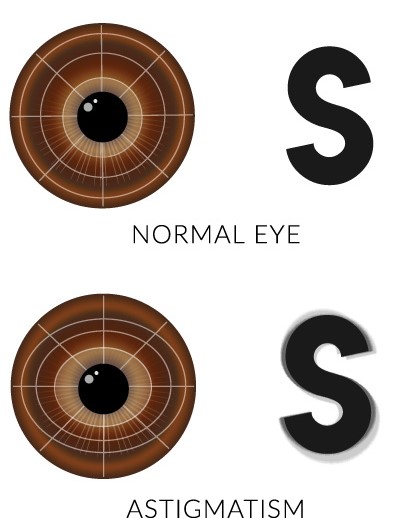
Astigmatism is an optical irregularity in the eye that can be corrected non-surgically or surgically. Astigmatism is due to the cornea being oval like a football, rather than round like a basketball. The oval shape of the cornea focuses light in an irregular manner that can only be corrected non-surgically by a counteracting astigmatism correction in glasses or an astigmatic contact lens.
Reducing a person’s astigmatism surgically can reduce the corresponding dependence on glasses.
In patients with naturally-occurring astigmatism, we can take the opportunity at the time of their cataract surgery with custom-matched, multifocal, or accommodating lens implants to surgically reduce their astigmatism. The astigmatism reduction is accomplished by making relaxing incisions at the edge of the cornea in its steeper axis during laser-assisted cataract and lens implant surgery. The relaxing incisions flatten the cornea in this axis and lead to an overall rounding of the cornea. There is some variability to this astigmatism correction method, but it generally works well for patients with less than 1.00 diopter of astigmatism.
Astigmatism correcting lens implants for patients with higher amounts of astigmatism, greater than 1.00 diopter, are now available and work quite well. For higher amounts of astigmatism (above 1.00 diopter), we are recommending astigmatism (Toric) lens implant program. These lenses have astigmatism correction built in and are oriented on axis with astigmatism. To use these implants, the capsular bag must be perfect (no tears and with adequate support). Less than 5% of these astigmatism lens implants will rotate off-axis enough to require re-positioning with a second surgery. Other options for astigmatism correction include PRK or LASIK. This laser vision correction rounds up the central cornea in front of the pupil to reduce astigmatism. The surgeon will decide which type of astigmatism correction is best for each patient.
Will my cataract surgery be performed as an outpatient?
Yes. Nearly all cataract and lens implant surgery is performed on an outpatient basis. Patients come to the Eye Surgery and Laser Center, LLC located in the same building as the Eye Specialists of Mid-Florida, P.A. Please plan to be with us for two to three hours for cataract and lens implant surgery. Also, Medicare and private insurance carriers cover the costs of cataract and lens implant surgery with lowest out-of-pocket expense to the patient when it is performed at an approved ambulatory surgery center. Utilizing the Eye Surgery & Laser Center, LLC means our patients are provided with optimal care at the least personal expense.
What happens during surgery?
Before surgery, patients with a history of heart trouble or other significant medical problems may need an EKG and/or blood work to determine the patient’s general state of health. As required by law, the patient is requested to read and sign a statement of informed consent indicating that he/she understands his/her options concerning surgery, understands that there are risks and possible complications, and consents to the operation as planned.
At the time of scheduling the date for surgery, the patient is given a prescription for antibiotic drops to be filled and used in the eye to be operated on starting on the day prior to the surgery. These antibiotic drops are to be brought to the surgery center on the day of surgery, to be used after the surgery. One hour before the operation, antibiotic drops are placed in the eye. The pupil is dilated with drops and the patient receives some sedative medication.
Usually, cataract surgery is performed with intravenous (IV) sedation. Very rarely is general anesthesia required for medical or other reasons. In the operating suite, intravenous medications are used to make the patient comfortable. The eye is totally numbed without injections for most patients. The skin around the eye is cleansed, and sterile drapes are placed around the eye. The eyelids are held open with a spring device called a speculum. Under an operating microscope, the small-incision, no-stitch cataract, and foldable intraocular lens implant surgery is performed as described previously. There may be some sensation of the doctor working and touching around the eye. However, there should be no pain during the surgery.
Most patients do not require a patch. Some moderate scratchiness can be expected the first day or two; this resolves quickly. The vision in the operated eye will be blurry the first day due to the dilation. As the dilation wears off in a few days, the vision should clear quickly.
